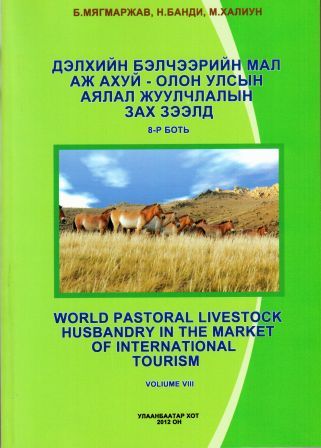World pastoral livestock husbandry in the market of International tourism
Volume 8

The World pastoral livestock husbandry in the international market
Contents:
Foreword :
Introduction:
First part: world pastoral Livestock and International tourism
Chapter one: Position of the world pastoral Livestock and rural tourism
1.1. Countries and regions with pastoral livestock husbandry
1.2. Climate, water, soil, and plant
1.3. Typology and peculiarities of nomads’ of the countries
1.4. Changing ratio for pastoral livestock in the world pastoral husbandry
1.5. Change and rate of five different livestock with Pastoral livestock countries’ in the world livestock
1.6. Rate reform and volume of the rural with pastoral countries having pastoral livestock husbandry in the world population and nomads are basic of rural tourism
Second part: Comparative Studies of the Nomadic Livestock Husbandry and tourism
Chapter two: Production and statistics of the Nomadic Livestock
2.1. Location of the livestock and foreign tourist
2.2. Structure of the livestock breeds
2.3. Statistical growth of the livestock breeds
2.4. Growth of livestock production and foreign tourist
2.5. Quality standard of the livestock
Chapter three: Correlation between nomadic livestock husbandry and their value
3.1. Livestock husbandry and index agriculture
3.2. Livestock husbandry and agriculture
3.3. Livestock husbandry and haymaking
3.4. Livestock husbandry and food production
3.5. Livestock husbandry and light industry
3.6. Livestock husbandry and foreign trade
Chapter four: Diversity of Nomadic Livestock Husbandry
4.1. Diversity of livestock breeding
4.2. Specialization of meat production
4.3. Specialization of milk production
4.4. Specialization of wool production
4.5. Specialization of cashmere production
Chapter five: Livestock Products of Pastoral countries in the World Livestock Industry
5.1. World meat industry
5.2. World milk industry
5.3. World wool and cashmere industry
5.4. World leather preparation
Third part: World pastoral Livestock, its brand products and international market of tourism.
Chapter six: Pastoral livestock, society, economy, and international market of tourism
6.1. Pastoral livestock husbandry and human resource
6.2. Pastoral livestock husbandry and ecology
6.3. Pastoral livestock husbandry and animal
6.4. Pastoral livestock husbandry, settled and nomadic civilization
6.5. Pastoral livestock husbandry and sport, tourism
6.6. Pastoral livestock husbandry and culture
6.7. Pastoral livestock husbandry and war
6.8. Pastoral livestock husbandry and management
6.9. Pastoral livestock husbandry and production of energy
6.10. Pastoral livestock husbandry and science and technology process
6.11. Pastoral livestock husbandry and real factor (example of sea buckthorn industry)
6.12. Pastoral livestock husbandry and environment international law and economy
6.13. Pastoral livestock husbandry and disadvantage and advantage
6.14. Pastoral livestock husbandry and many countries and much kind of religions
6.15. Pastoral livestock husbandry and environmental region of Mongolian ‘Khustai’ national park and tourism based on rural people
Chapter seven: Mongolian wool and cashmere products, its brand, international tourism and their relationship with the world market
7.1. Mongolian wool and cashmere, production
7.2. Mongolian wool and cashmere and its brand – in international market
7.3. Mongolian wool and cashmere and its brand – in continent and the world market
Chapter eight: New seven wonder of the world, nomads and their well known wonders of the world
8.1. Petraj and nomad
8.2. Great wall of China and Mongolian nomads
8.3. Taj Mahal and Moguls
8.4. Pearl of khubilai Khan
8.5. Mongolian rock painting – one of the world wonders
8.6. Chinggis Khan’s bush - future 8th wonder of the world
- Bibliography
- Atlas and Photos
- Appendix
- Program of the 3 credit universities